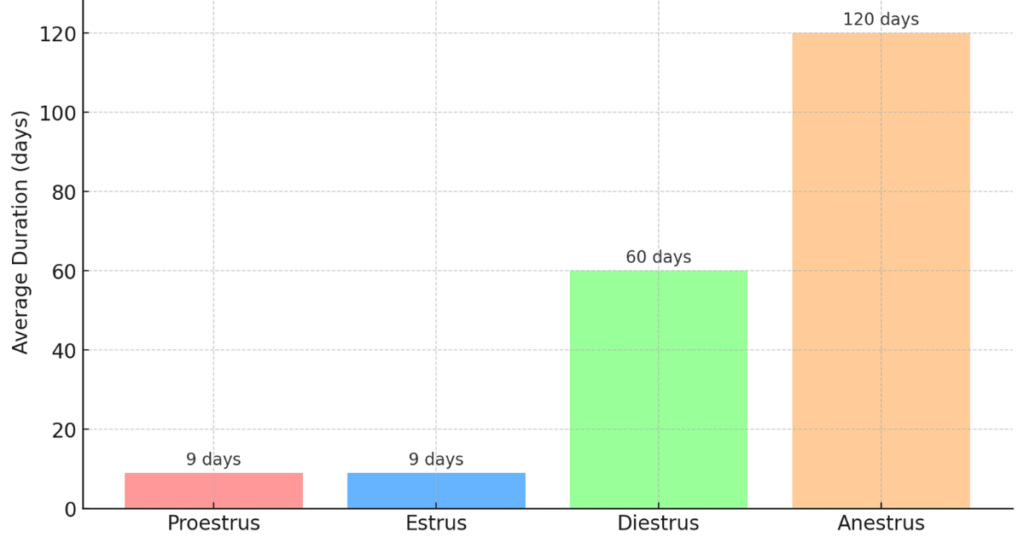
As a dog owner, you want the best for your furry friend.
When your female dog is in her estrous cycle, she may experience discomfort. This is similar to period cramps in humans.
Understanding these cramps and how to relieve them is crucial. It ensures your pet’s comfort and health during this natural process.
In this guide, we’ll explore the symptoms of dog period cramps. We’ll also discuss various relief methods, from natural remedies to vet-approved medications.
Whether you’re a seasoned dog owner or a first-time pet parent, this article will provide valuable insights.
Let’s help your dog navigate her estrous cycle with as little discomfort as possible.
Understanding Canine Estrous Cycle and Period Cramps
The estrous cycle in dogs is their version of the menstrual cycle. It’s a natural process that female dogs undergo if they’re not spayed.

This cycle has four stages: proestrus, estrus, diestrus, and anestrus. Each stage has its own set of symptoms and behaviors.
During the proestrus and estrus stages, your dog may experience discomfort. This is similar to period cramps in humans.
Here are the key points to remember about the canine estrous cycle:
- Proestrus: This is the start of the heat cycle. Your dog may show signs of discomfort and there may be a bloody discharge.
- Estrus: This is when your dog is receptive to mating. Discomfort may continue during this stage.
- Diestrus: Pregnancy occurs in this stage if mating happened. If not, your dog’s body will return to normal.
- Anestrus: This is the resting stage before the cycle starts again.
Understanding these stages can help you better manage your dog’s discomfort. It’s the first step in providing effective dog period cramps relief.
Recognizing Symptoms of Dog Period Cramps
Recognizing the symptoms of period cramps in dogs is crucial. It helps you provide the right care and relief for your pet.

One common sign is a change in behavior. Your dog may seem more anxious or irritable than usual. She may also be more clingy, seeking comfort from you.
Physical signs can include a swollen vulva and bloody discharge. Your dog may also lick her genital area more frequently.
In some cases, dogs may show signs of physical discomfort. They may have a hunched back or show reluctance to move.
Understanding these symptoms can help you provide timely relief. It also helps you decide when to consult a vet for further advice.
When to Consult a Veterinarian
While some discomfort is normal during a dog’s heat cycle, severe pain is not. If your dog seems to be in significant distress, it’s time to consult a vet.
Excessive bleeding, loss of appetite, or lethargy are also cause for concern. These could indicate a more serious health issue, such as an infection or hormonal imbalance.
Remember, it’s always better to be safe than sorry. If you’re unsure about your dog’s symptoms, don’t hesitate to seek professional advice. Your vet can provide the best guidance and treatment options for your pet’s condition.
Natural Remedies for Dog Period Cramps Relief
There are several natural remedies that can help alleviate your dog’s period cramps. These methods are simple and can be done at home. However, they should not replace a visit to the vet if your dog is in severe pain.

Some of these remedies include warm compresses, gentle massage, providing a comfortable resting area, and ensuring proper nutrition and hydration. Let’s explore each of these in more detail.
Warm Compresses and Gentle Massage
Applying a warm compress to your dog’s abdomen can help soothe cramps. Be sure the compress is not too hot to avoid burns. Gentle massage can also help. It can relax your dog and improve blood flow, which can reduce cramping.
Comfortable Resting Area
Ensure your dog has a comfortable place to rest. Soft bedding can provide extra comfort during this uncomfortable time. Try to keep the area quiet and calm. This can help reduce stress, which can exacerbate cramps.
Proper Nutrition and Hydration
Proper nutrition is crucial during a dog’s heat cycle. A balanced diet can help maintain overall health and reduce discomfort. Hydration is also key. Make sure your dog has access to fresh water at all times. This can help prevent dehydration, which can worsen cramps.
Exercise and Environmental Comfort
Regular exercise can help alleviate period cramps in dogs. It promotes blood flow and can reduce discomfort.

However, it’s important to not overdo it. Too much exercise can lead to fatigue and worsen cramps.
Creating a comfortable environment is also crucial. Keep the temperature moderate and provide a quiet space for your dog to rest.
Remember, every dog is different. What works for one may not work for another. Always monitor your dog’s response to these methods and adjust as necessary.
Medical Interventions and Pain Relief
In some cases, natural remedies may not be enough. Your vet can provide medical interventions for dog period cramps relief.

These may include vet-approved pain relief medications. Always consult your vet before giving your dog any medication.
Remember, over-the-counter pain medications for humans can be harmful to dogs. Never give your dog human medication without vet approval.
Vet-Approved Medications
Vet-approved medications can provide relief for your dog. These are specially formulated for dogs and their unique physiology.
However, these should only be used under the guidance of a vet. Misuse can lead to serious health issues.
Spaying as a Long-Term Solution
Spaying is a surgical procedure that removes the reproductive organs. It can prevent future estrous cycles and associated discomfort.
However, it’s a major decision that should be discussed with your vet. It has both pros and cons that need to be considered.
Monitoring and Managing a Dog’s Heat Cycle
Monitoring your dog’s heat cycle is crucial. It helps you anticipate when your dog might experience period cramps.

Keep track of symptoms and changes in behavior. This can help you provide timely relief and care.
Here are some tips for monitoring:
- Keep a calendar or diary of your dog’s heat cycle.
- Note any changes in behavior, appetite, or physical appearance.
- Consult your vet if you notice any unusual or concerning symptoms.
Remember, understanding your dog’s cycle can help you provide the best care possible.
Conclusion and Final Thoughts
Managing dog period cramps can be challenging. But with the right knowledge and care, you can help your pet navigate this natural process with ease.
Remember, your vet is your best resource for any concerns or questions. Always prioritize your dog’s comfort and well-being.
